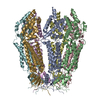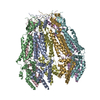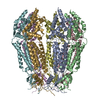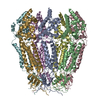+ Open data
Open data
- Basic information
Basic information
| Entry | Database: PDB / ID: 8dxr | ||||||
|---|---|---|---|---|---|---|---|
| Title | Structure of LRRC8C-LRRC8A(IL125) Chimera, Class 5 | ||||||
 Components Components | Volume-regulated anion channel subunit LRRC8C,Volume-regulated anion channel subunit LRRC8A | ||||||
 Keywords Keywords | TRANSPORT PROTEIN / LRRC8C / LRRC8A / SWELL / VRAC / Chimera | ||||||
| Function / homology |  Function and homology information Function and homology informationpre-B cell differentiation / Miscellaneous transport and binding events / volume-sensitive anion channel activity / aspartate transmembrane transport / cyclic-GMP-AMP transmembrane transporter activity / cyclic-GMP-AMP transmembrane import across plasma membrane / monoatomic anion transmembrane transport / taurine transmembrane transport / protein hexamerization / cell volume homeostasis ...pre-B cell differentiation / Miscellaneous transport and binding events / volume-sensitive anion channel activity / aspartate transmembrane transport / cyclic-GMP-AMP transmembrane transporter activity / cyclic-GMP-AMP transmembrane import across plasma membrane / monoatomic anion transmembrane transport / taurine transmembrane transport / protein hexamerization / cell volume homeostasis / cellular response to osmotic stress / monoatomic anion transport / response to osmotic stress / fat cell differentiation / intracellular glucose homeostasis / monoatomic ion channel complex / positive regulation of myoblast differentiation / chloride transmembrane transport / positive regulation of insulin secretion / spermatogenesis / intracellular signal transduction / lysosomal membrane / endoplasmic reticulum membrane / cell surface / identical protein binding / membrane / plasma membrane / cytoplasm Similarity search - Function | ||||||
| Biological species |  Homo sapiens (human) Homo sapiens (human) | ||||||
| Method | ELECTRON MICROSCOPY / single particle reconstruction / cryo EM / Resolution: 4 Å | ||||||
 Authors Authors | Takahashi, H. / Yamada, T. / Denton, J.S. / Strange, K. / Karakas, E. | ||||||
| Funding support |  United States, 1items United States, 1items
| ||||||
 Citation Citation |  Journal: Elife / Year: 2023 Journal: Elife / Year: 2023Title: Cryo-EM structures of an LRRC8 chimera with native functional properties reveal heptameric assembly. Authors: Hirohide Takahashi / Toshiki Yamada / Jerod S Denton / Kevin Strange / Erkan Karakas /  Abstract: Volume-regulated anion channels (VRACs) mediate volume regulatory Cl and organic solute efflux from vertebrate cells. VRACs are heteromeric assemblies of LRRC8A-E proteins with unknown ...Volume-regulated anion channels (VRACs) mediate volume regulatory Cl and organic solute efflux from vertebrate cells. VRACs are heteromeric assemblies of LRRC8A-E proteins with unknown stoichiometries. Homomeric LRRC8A and LRRC8D channels have a small pore, hexameric structure. However, these channels are either non-functional or exhibit abnormal regulation and pharmacology, limiting their utility for structure-function analyses. We circumvented these limitations by developing novel homomeric LRRC8 chimeric channels with functional properties consistent with those of native VRAC/LRRC8 channels. We demonstrate here that the LRRC8C-LRRC8A(IL1) chimera comprising LRRC8C and 25 amino acids unique to the first intracellular loop (IL1) of LRRC8A has a heptameric structure like that of homologous pannexin channels. Unlike homomeric LRRC8A and LRRC8D channels, heptameric LRRC8C-LRRC8A(IL1) channels have a large-diameter pore similar to that estimated for native VRACs, exhibit normal DCPIB pharmacology, and have higher permeability to large organic anions. Lipid-like densities are located between LRRC8C-LRRC8A(IL1) subunits and occlude the channel pore. Our findings provide new insights into VRAC/LRRC8 channel structure and suggest that lipids may play important roles in channel gating and regulation. | ||||||
| History |
|
- Structure visualization
Structure visualization
| Structure viewer | Molecule:  Molmil Molmil Jmol/JSmol Jmol/JSmol |
|---|
- Downloads & links
Downloads & links
- Download
Download
| PDBx/mmCIF format |  8dxr.cif.gz 8dxr.cif.gz | 371.1 KB | Display |  PDBx/mmCIF format PDBx/mmCIF format |
|---|---|---|---|---|
| PDB format |  pdb8dxr.ent.gz pdb8dxr.ent.gz | 236.5 KB | Display |  PDB format PDB format |
| PDBx/mmJSON format |  8dxr.json.gz 8dxr.json.gz | Tree view |  PDBx/mmJSON format PDBx/mmJSON format | |
| Others |  Other downloads Other downloads |
-Validation report
| Summary document |  8dxr_validation.pdf.gz 8dxr_validation.pdf.gz | 1.4 MB | Display |  wwPDB validaton report wwPDB validaton report |
|---|---|---|---|---|
| Full document |  8dxr_full_validation.pdf.gz 8dxr_full_validation.pdf.gz | 1.4 MB | Display | |
| Data in XML |  8dxr_validation.xml.gz 8dxr_validation.xml.gz | 58.6 KB | Display | |
| Data in CIF |  8dxr_validation.cif.gz 8dxr_validation.cif.gz | 92.4 KB | Display | |
| Arichive directory |  https://data.pdbj.org/pub/pdb/validation_reports/dx/8dxr https://data.pdbj.org/pub/pdb/validation_reports/dx/8dxr ftp://data.pdbj.org/pub/pdb/validation_reports/dx/8dxr ftp://data.pdbj.org/pub/pdb/validation_reports/dx/8dxr | HTTPS FTP |
-Related structure data
| Related structure data |  27774MC  8dxnC  8dxoC  8dxpC  8dxqC C: citing same article ( M: map data used to model this data |
|---|---|
| Similar structure data | Similarity search - Function & homology  F&H Search F&H Search |
- Links
Links
- Assembly
Assembly
| Deposited unit | 
|
|---|---|
| 1 |
|
- Components
Components
| #1: Protein | Mass: 94747.695 Da / Num. of mol.: 7 Source method: isolated from a genetically manipulated source Source: (gene. exp.)  Homo sapiens (human) Homo sapiens (human)Gene: LRRC8C, AD158, FAD158, LRRC8A, KIAA1437, LRRC8, SWELL1, UNQ221/PRO247 Cell line (production host): Sf9 / Production host:  |
|---|
-Experimental details
-Experiment
| Experiment | Method: ELECTRON MICROSCOPY |
|---|---|
| EM experiment | Aggregation state: PARTICLE / 3D reconstruction method: single particle reconstruction |
- Sample preparation
Sample preparation
| Component | Name: LRRC8C-LRRC8A(IL125) chimera / Type: COMPLEX / Details: Heptameric LRRC8C-LRRC8A(IL125) chimera. / Entity ID: all / Source: RECOMBINANT | ||||||||||||||||||||
|---|---|---|---|---|---|---|---|---|---|---|---|---|---|---|---|---|---|---|---|---|---|
| Molecular weight | Value: 0.7 MDa / Experimental value: NO | ||||||||||||||||||||
| Source (natural) | Organism:  Homo sapiens (human) Homo sapiens (human) | ||||||||||||||||||||
| Source (recombinant) | Organism:  | ||||||||||||||||||||
| Buffer solution | pH: 8 | ||||||||||||||||||||
| Buffer component |
| ||||||||||||||||||||
| Specimen | Conc.: 3 mg/ml / Embedding applied: NO / Shadowing applied: NO / Staining applied: NO / Vitrification applied: YES | ||||||||||||||||||||
| Specimen support | Grid material: GOLD / Grid mesh size: 300 divisions/in. / Grid type: UltrAuFoil R1.2/1.3 | ||||||||||||||||||||
| Vitrification | Instrument: FEI VITROBOT MARK IV / Cryogen name: ETHANE / Humidity: 100 % / Chamber temperature: 281 K |
- Electron microscopy imaging
Electron microscopy imaging
| Experimental equipment |  Model: Titan Krios / Image courtesy: FEI Company |
|---|---|
| Microscopy | Model: FEI TITAN KRIOS |
| Electron gun | Electron source:  FIELD EMISSION GUN / Accelerating voltage: 300 kV / Illumination mode: FLOOD BEAM FIELD EMISSION GUN / Accelerating voltage: 300 kV / Illumination mode: FLOOD BEAM |
| Electron lens | Mode: BRIGHT FIELD / Nominal defocus max: 2200 nm / Nominal defocus min: 800 nm |
| Image recording | Electron dose: 54 e/Å2 / Film or detector model: GATAN K3 BIOQUANTUM (6k x 4k) / Num. of real images: 3198 |
- Processing
Processing
| EM software |
| ||||||||||||||||||
|---|---|---|---|---|---|---|---|---|---|---|---|---|---|---|---|---|---|---|---|
| CTF correction | Type: PHASE FLIPPING ONLY | ||||||||||||||||||
| Particle selection | Num. of particles selected: 846122 | ||||||||||||||||||
| Symmetry | Point symmetry: C1 (asymmetric) | ||||||||||||||||||
| 3D reconstruction | Resolution: 4 Å / Resolution method: FSC 0.143 CUT-OFF / Num. of particles: 85591 / Num. of class averages: 1 / Symmetry type: POINT | ||||||||||||||||||
| Atomic model building | Protocol: FLEXIBLE FIT / Space: REAL |
 Movie
Movie Controller
Controller







 PDBj
PDBj





